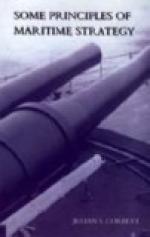In considering open blockade, three postulates must be kept in mind. Firstly, since our object is to get the enemy to sea, our position must be such as will give him an opportunity of doing so. Secondly, since we desire contact for a decisive battle, that position must be no further away from his port than is compatible with bringing him to action before he can effect his purpose. Thirdly, there is the idea of economy—that is, the idea of adopting the method which is least exhausting to our fleet, and which will best preserve its battle fitness. It is on the last point that the greatest difference of opinion has existed. A close blockade always tended to exhaust a fleet, and always must do so. But, on the other hand, it was contended that the exhaustion is compensated by the high temper and moral domination which the maintenance of a close blockade produces in a good fleet, whereas the comparative ease of distant and secure watch tended to deterioration. Before considering these opposed views, one warning is necessary. It is usually assumed that the alternative to close blockade is watching the enemy from one of our own ports, but this is not essential. What is required is an interior and, if possible, a secret position which will render contact certain; and with modern developments in the means of distant communication, such a position is usually better found at sea than in port. A watching position can in fact be obtained free from the strain of dangerous navigation and incessant liability to attack without sacrifice of sea training. With this very practical point in mind, we may proceed to test the merits of the two forms on abstract principles.
It was always obvious that a close naval blockade was one of the weakest and least desirable forms of war. Here again when we say “weakest” we do not mean “least effective,” but that it was exhausting, and that it tended to occupy a force greater than that against which it was acting. This was not because a blockading fleet, tempered and toughened by its watch, and with great advantage of tactical position, could not be counted on to engage successfully a raw fleet of equal force issuing from port, but because in order to maintain its active efficiency it required large reserves for its relief. So severe was the wear and tear both to men and ships, that even the most strenuous exponents of the system considered that at least a fifth of the force should always be refitting, and in every case two admirals were employed to relieve one another. In 1794 one of the highest authorities in the service considered that to maintain an effective close blockade of Brest two complete sets of flag-officers were necessary, and that no less than one-fourth of the squadron should always be in port.[16]




